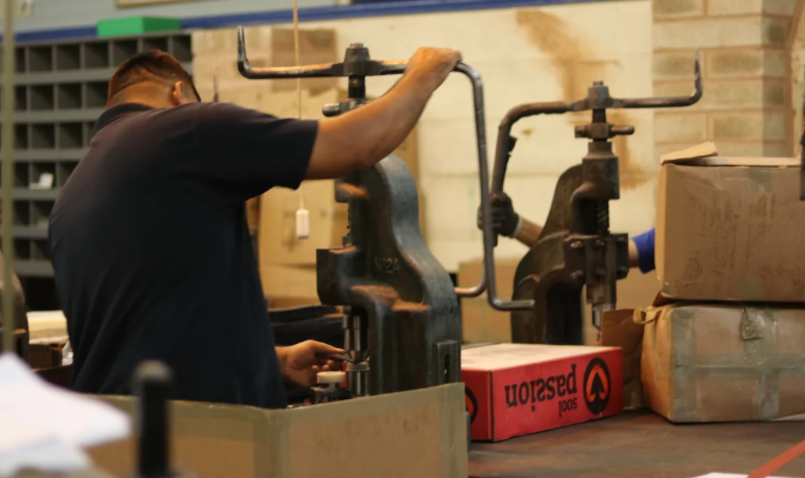RH Nuttall Ltd
RH Nuttall Limited is a family owned and run business based in the UK. A leading manufacturer of all non metallic washers, gaskets, seals, insulations, rubber strip, foam strip and sheeting since 1860.
RH Nuttall Limited was established in 1860 and has become a leading manufacturer of all non metallic parts including Rubber Strip, Foam Strip, Neoprene Washers, EPDM Strip, Rubber Tape, Expanding Foam Tape, Nylon Gaskets, Self Adhesive Rubber Strips, Acoustic Foam Sheet, PTFE Washers, Mouse Mat Foam Pads and many more. All parts can be supplied plain or adhesive backed.
Industries we supply include marine, construction, automotive, electronics, aerospace and many more.
-
Dealing with Customer Complaints Should be Part of Your Marketing Strategy
11 September 2020There are two certainties in life: death and taxes.
Only, there’s actually another one – customer complaints. You see, no matter how great your business is, you’ll at some stage receive a complaint from a disgruntled customer.
You can’t please everyone, but ignoring customer complaints isn’t an option. In fact, dealing with them should be a core part of your marketing strategy.
Here’s why.
The world is watching
Some customer complaints will take place in person or over the phone. If you’re lucky.
More often than not, customer complaints in the digital economy will take place online, and that means they’re available for everyone to see.
With the world watching, it’s vital you demonstrate a consistent, measured, fair and proactive approach to dealing with customer complaints.
Customers can leave reviews for businesses on a number of websites, so make sure you keep an eye on those that relate to your business and jump positively on any negative reviews or complaints you find.
You can turn a bad situation around
Customers complain for a reason. Whatever that reason is, and regardless of whether or not you agree with it, it’s clearly been enough to make them do something about it.
The good news? This is actually great engagement with your company. If someone feels that passionately about something you’ve done as a business, you have the opportunity to turn them around.
Complaints are often a cry for help, so the next time you receive one, treat it as an opportunity to get that person back on side.
You might learn something
Complaints often include key learnings.
They may be difficult to swallow, but if you’re prepared to accept that complaints might help you learn something about your product or service, they become incredibly valuable.
So, swallow your pride, and delve into the complaints you receive. Where can you improve?
This will often require a more detailed, one-to-one conversation with the person who has complained, but that relates to our previous point; you may very well turn a bad situation around if you display this proactive approach.
Reputation management is essentialWe can’t stress this enough: your online reputation, and the one you present in the real world, is key to success.
Businesses that last, grow and discover new revenue streams will have spent considerable time on customer service and their reputation management – it’ll be something that’s discussed regularly at board level meetings.
Reputation management extends throughout the entire operation, too. Therefore, when you receive a customer complaint, it’s important for the whole company to take ownership of it and to address the issues raised.
The more obvious your positive approach to complaints is, the more likely you are to create a brand that shines brightly in the eyes of prospective customers.
Wrapping up
Don’t be afraid of customer complaints – you’ll receive them, no matter how great your business becomes.
Complaints can actually offer a huge opportunity to win back customers, learn where you can improve, and turn bad situations into revenue-making opportunities.
-
How to Raise Productivity in a Small Team
11 September 2020There’s nothing more frustrating than watching the level of productivity within your small team drop.
Your first thought might be a common one: it’s their fault. For whatever reason, they simply can’t be bothered to work hard enough for you.
However, do you really know that’s the case? Or do you need to look deeper?
Most small teams that suffer bouts of poor productivity don’t want to be in that position. They want to do the very best work. Something is simply stopping them from doing so.
Here are five ways to empower your small team to be more productive.
1. Give them ownership of their tasks
Try this.
Pull a couple of team members to one side and ask whether they feel in control of the work you have given them, and whether they understand exactly why they’re doing each task?
If they don’t, they’ll probably be forthcoming with why, and it might simply be because you haven’t given them full ownership of it. If so, pull back slightly, stop micro-managing and empower them to make their own decisions about how best to forge ahead.
2. Establish communication as a vital productivity tool
Projects often break down or take longer to complete because teams don’t communicate properly with one another.
This is why great communication should be championed throughout your organisation.
Give them the most effective tools to do so (even if it involves creating a work WhatsApp group), and tell them to never leave communication to chance.
3. Do some team building
It might sound like a bit of a cliché, but team building is still a great way to ensure your team works effectively together.
Team building can be anything. For instance, it might just be a monthly trip to the pub or an ad-hoc quiz. Whatever it is, make it regular and fun; that way, you won’t have to demand that people take part – they’ll do so off their own back.
4. Offer the best possible working environment
Take a look around the working environment you offer staff. Is it set up for maximum productivity?
If the walls are a dull grey, the office furniture is falling apart and there’s limited natural light, how do you expect the team to feel motivated and be fully productive?
Make some positive changes to improve everyone’s morale and mood – add some colour and ensure the working environment is a delight to step into each day.
5. Offer incentives (they don’t have to be monetary)
Good news – employee incentives don’t have to come in the form of pay rises or bonuses.
In fact, if you’re experiencing low levels of productivity, smaller, more regular incentives will work far better when it comes to helping the team to rediscover their mojo.
A free day off, an extended lunch break, or top place on the employee ‘great idea’ leader board are just some examples of incentive schemes that work, and which don’t cost a fortune.
Wrapping up
Some of these tips might feel a bit alien to some business owners. After all, it is so easy to get stuck in a rut when running a business, without realising the hidden effects this may be having on your team.
On the bright side, these tips should help you to sniff out the root causes of any declines in your employees’ productivity. Just be sure to act on them once you know what they are!
-
The Super Simple Elevator Pitch Guide
11 September 2020We can almost guarantee you’ve heard of the phrase ‘elevator pitch’. If you’re heading to a networking event or need to produce some kind of presentation, people will tell you it’s a prerequisite.
But, what is an elevator pitch? Is it just more business speak that is best ignored, or can it provide real value?
Let’s cover that last question first: elevator pitches are incredibly useful. They cut through the jargon, dispense with waffle, and quickly get to the point of how you can help people with your product or service.
What is an elevator pitch, though?
It’s best to think of an elevator pitch as a super-simple summary of either yourself, a business, or a product.
That’s it. There are lots of opinions on the ideal length of an elevator pitch, but the general rule of thumb is that they shouldn’t last any longer than 30 seconds.
Elevator pitches should roll off the tongue and be incredibly easy to remember.
Here’s how to create yours.
1. Introduce yourself
Who are you?
This is the easy bit. Your name, position, and the event or reason for being where you are.
2. Summarise what you do
This is often much harder than you might think to condense into just a few words.
‘What you do’ in this context is a simple summary of your education, your work experience, and what you do each day to benefit your customers, staff or partners.
You may need to tailor this depending on where you’re intending to use your elevator pitch, but try to avoid any hyperbole or needless navel-gazing.
Here’s a great example:
“Hi, my name is Dave, great to meet you. I’m a marketing manager focused on ensuring content marketing strategies deliver a great return on investment. My degree in marketing and five years working for a leading marketing agency help me to gain customer trust.”
3. Explain what you’re after
You want something after this pitch – of course you do – but what is it?
It’s important to be honest and transparent in your elevator pitch, so don’t shy away from explaining exactly what it is you need.
Perhaps you want the opportunity to demonstrate your new product, or maybe you simply want to make some valuable connections. Whatever it is, know your objective beforehand, and be determined to achieve it – without being too pushy or annoying, obviously.
4. Always end with a simple call to action (CTA)
Miss this step, and your entire elevator pitch is practically rendered useless.
A CTA will explain what you want to happen next after you’ve finished speaking. If, for instance, you want your audience to grab your business card or head to a website to download your fancy new free guide, then point them in that direction.
Just remember to keep your call to action simple, easy to follow, and memorable.
Wrapping up
You’ll find so much use for your elevator pitch. It’s a great way to break the ice when engaging in conversations, and one of the best tools you’ll have for promoting yourself and your business.
Have fun writing your elevator pitch – you’ll call on it far more often than you think.
-
Strategies for Getting More Stuff Done In Half The Time
11 September 2020It sounds like an impossible dream, doesn’t it? The idea of getting more stuff done in half the time it would normally take is surely akin to somehow inventing more time.
And that’s impossible, right?
Well, yes, it is. But improving your productivity and efficiency to a point where you can literally do more in the time you have available isn’t impossible. Far from it, in fact.
Here are five brilliant strategies that will help you get more done and gain more time for yourself in the process.
1. Revisit your expectations
When you take on a big task, how often do you ask the stakeholders what they expect from you?
If you don’t get a handle on what they actually want, you might dive in head first assuming that it needs a massive amount of time spending on it.
In some instances, you might actually discover that you don’t need to spend half the amount of time on a project than you had assumed.
2. Re-purpose wherever you can
Depending on the type of project you’re working on, you might have the opportunity to repurpose older stuff.
This isn’t a shortcut that should be frowned upon, either. For instance, it’s a much-used strategy in content marketing where bloggers, video makers and podcasters return to old content to rejuvenate it.
You can do the same with report writing, product design and even graphic design. If you created something amazing a while ago and it relates to what you’re working on now, dig it out for inspiration.
3. Work from templates
If possible, working from templates is a great way to speed up your working processes.
Think about the various projects you undertake and how often you run through the same initial setup routine. That can be cut completely by creating a pre-prepared template.
You’ll obviously have to invest some time in creating that template, but that’s a once-only affair, and will save heaps of time in the long term.
4. Use conversation rather than writing
Writing anything takes a fair bit of time – particularly if writing isn’t something you’re particularly proficient at, or comfortable with.
This is why, sometimes, it’s best to make your work a conversation. For example, if you’ve finished a big report, why go on to write a lengthy email explaining what it’s all about if you can instead pick up the phone and talk to the person you were going to send the email to?
Talking, usually, takes half the amount of time it would take to write the same thing.
5. Time block
Time blocking is a great way to train your mind and body to work deeply on tasks.
Deep working is a great way to really get into the groove of something without being distracted. In turn, that should almost certainly mean you complete whatever it is you’re working on in a much shorter time.
Think of time blocking like booking time with yourself in the diary. It might sound odd, but it works – big time.
Wrapping up
You only have so many hours in the day. Use our tips above, and you’ll slowly begin to claw more of them back for far more exciting things.
-
The Essential Elements of Professional Business Cards
11 September 2020You’d be forgiven for assuming that professional business cards are a bit old-fashioned and no longer relevant in the era of LinkedIn and social media.
Not so. They’re still incredibly useful.
The problem lies in the fact that too many business cards are poorly designed and not properly thought through.
The next time you head to a networking event, it’s vital you have some business cards with you if you want to make meaningful connections that go beyond that first meeting.
Here are five things your business card needs, without question.
1. Your logo and tagline
Your professional business card is an extension of your brand. Therefore, just like any form of marketing or advertising, it needs to be branded.
Don’t go overboard, though. Instead, just add your logo and tagline. That way, you’ll draw the eye to the central part of your brand and immediately tell the person holding the card what you’re all about.
2. ZERO waffle
No one wants to know about your multiple awards, endless list of services or customer testimonials – particularly on your business card.
People simply need to know who you are (name), what you’re about (brief tagline), and how you can help them to solve a problem or make their lives easier (brief mission statement) – and they want the information delivered as briefly as possible.
With this in mind, make sure you don’t have any waffle on your business card. Ensure it’s completely devoid of anything but the stuff people need to know when they pick it up.
If you ramble on about how great your company is, they’ll get bored or simply won’t bother to get back in touch. Brutal, but true.
3. Social media details
Hopefully, your business has an active, engaging presence on social media, and that’s why you should point people to your profiles on your business card.
Firstly, this will ensure you grab some extra followers, but it’ll also give them another way to get in touch with you. Even with your telephone number and email address on the business card, some people might prefer to contact you via Twitter. Give them the option to do so.
4. Contact info (and a simple website URL)
Your name, mobile number and one email address is all you need. Don’t add loads of phone numbers or multiple email addresses.
It’s also vitally important to include your website address. If you suffer from a long-winded URL, create a shortened version, either with the help of your IT company or via one of the many URL shorteners you can find on the internet.
5. Plenty of white space (or blocks of colour)
This is probably the most important tip of the lot.
Plenty of blank space will allow the information on your business card to breathe. It’s a trick used in web design and other forms of advertising, and it works brilliantly.
The more space around your text the better. If your business card appears overwhelming with too many images and too much text, it’ll put the majority of people off.
Go minimal with your business card design, always.
Wrapping up
Now you know what your business card needs, it’s time to get creating. While doing so, don’t forget to keep the details above in mind at all times.
If nothing else, just remember to keep the design simple and ensure the key elements (your contact details) are easy to read, and that they immediately draw the eye.











